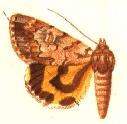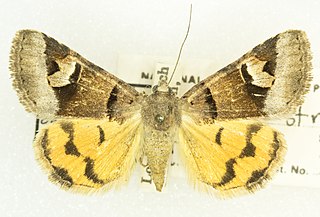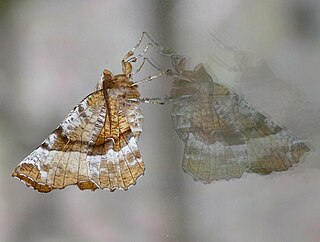
Drasteria is a genus of moths in the family Erebidae.

Catocala meskei, or Meske's underwing, is a moth of the family Erebidae. The species was first described by Augustus Radcliffe Grote in 1873. It is found in North America from Maine and Quebec west to southern Alberta and Montana, south to South Carolina in the east and at least Montana in the west.

Catocala praeclara, the praeclara underwing, is a moth of the family Erebidae. The species was first described by Augustus Radcliffe Grote and Coleman Townsend Robinson in 1866. It is found in North America from Nova Scotia west to south-eastern Alberta, south to Florida and Kansas.

Andropolia aedon is a moth in the family Noctuidae first described by Augustus Radcliffe Grote in 1880. It is found in North America from British Columbia and Alberta south to California.

Globia oblonga, the oblong sedge borer, is a moth of the family Noctuidae. The species was first described by Augustus Radcliffe Grote in 1882. It is found across southern Canada from the Maritimes to British Columbia, south to the Gulf of Mexico and southern California.

Globia subflava, the subflava sedge borer or yellow sedge borer, is a moth of the family Noctuidae. The species was first described by Augustus Radcliffe Grote in 1882. It is found in North America from Nova Scotia west to British Columbia, south to New Jersey in the east and Utah and California in the west.
Schinia persimilis, the persimilis flower moth, is a moth of the family Noctuidae. The species was first described by Augustus Radcliffe Grote in 1873. It is found from in western North America from east central Alberta and the Cypress Hills in Saskatchewan north to the southern Yukon, west and south to Colorado, Utah, California and Oregon.

Schinia villosa, the little dark gem, is a moth of the family Noctuidae. The species was first described by Augustus Radcliffe Grote in 1864. In North America, it is mostly a western mountain species, however it has also been found across the plains eastward across Alberta and Saskatchewan to southern Manitoba. To the west it is found up to the coast ranges of Washington and British Columbia, south to Arizona.

Colocasia propinquilinea, the closebanded yellowhorn, is a moth of the family Noctuidae. The species was first described by Augustus Radcliffe Grote in 1873. It is found in North America from Newfoundland and Labrador, west across the southern edge of the boreal forest to central Alberta, south to North Carolina, Missouri and Arkansas.

Drasteria adumbrata, the shadowy arches, is a moth of the family Erebidae. The species was first described by Hans Hermann Behr in 1870. It is found from coast to coast in southern Canada, south in the west to California and Colorado, south in the east to New England and Michigan. Subspecies D. a. alleni is found from eastern Alberta to New York and Nova Scotia. Subspecies D. a. saxea occurs from southern British Columbia and south-west Alberta south to California and Colorado.
Drasteria hudsonica, the northern arches, is a moth of the family Erebidae. The species was first described by Augustus Radcliffe Grote and Coleman Townsend Robinson in 1865. It is found from Alaska and Yukon to California, east to New Mexico and Manitoba.

Drasteria perplexa, the perplexing or perplexed arches, is a moth of the family Erebidae. The species was first described by Henry Edwards in 1884. It is found in North America from Alberta and Saskatchewan south to Colorado and Arizona.
Drasteria petricola, the little arches, is a moth of the family Erebidae. The species was first described by Francis Walker in 1858. It is found in western North America from Yukon and the Northwest Territories south to New Mexico in the Rocky Mountains, east to Manitoba.

Drasteria howlandii is a moth of the family Erebidae. It is found from British Columbia and Saskatchewan south through the western parts of the United States from Washington south to Arizona and Texas.
Melaporphyria immortua, the dark-banded flower gem, is a moth of the family Noctuidae. The species was first described by Augustus Radcliffe Grote in 1874. It is found in North America from New England west to Colorado, north to southern Manitoba, central Saskatchewan and Alberta.
Macrochilo bivittata, the two-striped snout-moth, is a litter moth of the family Erebidae. The species was first described by Augustus Radcliffe Grote in 1877. It is found from the Atlantic coast west across the parklands and southern boreal forest of North America to central Alberta, south to Massachusetts and Ohio.

Selenia kentaria, commonly known as Kent's thorn or Kent's geometer, is a moth of the family Geometridae. The species was first described by Augustus Radcliffe Grote and Coleman Townsend Robinson in 1867. It is found in eastern and central North America.

Gnophaela vermiculata, sometimes known as the police-car moth or green lattice, is a moth of the family Erebidae. The species was first described by Augustus Radcliffe Grote in 1864. It is found in the Rocky Mountain region of the United States and in western parts of North America, from British Columbia to California, east to New Mexico and north to Manitoba.

Heliomata cycladata, the common spring moth, is a moth of the family Geometridae. The species was first described by Augustus Radcliffe Grote and Coleman Townsend Robinson in 1866. It is found in eastern North America, with records from southern Ontario, southern Quebec, Maine, New Hampshire, Michigan, Wisconsin to South Carolina, Georgia, Alabama, northern Mississippi and Arkansas.

Pyrausta generosa is a moth in the family Crambidae. It was described by Augustus Radcliffe Grote and Coleman Townsend Robinson in 1867. It is found in North America, where it has been recorded from Ontario to Alberta and to Florida and Missouri. The habitat consists of undisturbed areas in aspen parkland and mixed woods.












